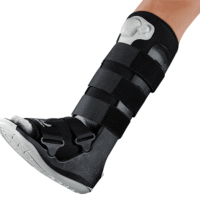Air Traveler
$108.99 – $147.43The Darco Air Traveler™ includes a circumferential air bladder and an inflation/deflation system that allows you to find the perfect balance between comfort and support.
 Achilles heel pain is a common foot and ankle complaint among physically active individuals. When it occurs it can be a major deterrent to continuing an active lifestyle and getting sufficient exercise. This is particularly the case for those whose physical activity tends to be mainly high impact in nature, such as running, walking or jumping.
Achilles heel pain is a common foot and ankle complaint among physically active individuals. When it occurs it can be a major deterrent to continuing an active lifestyle and getting sufficient exercise. This is particularly the case for those whose physical activity tends to be mainly high impact in nature, such as running, walking or jumping.
When it occurs among physically active individuals, this pain is usually the result of an Achilles tendon injury. The two most common types of Achilles tendon injuries are tendonitis and tendinosis. We will discuss the differences between these conditions later in this article.
Achilles heel pain can also sometimes befall less active individuals. When this happens, the underlying condition causing the pain is usually rheumatoid arthritis.
In this article, we will first discuss the nature of Achilles heel pain and the symptoms that accompany it when it is caused by Achilles tendonitis or Achilles tendinosis. We will then discuss the activities and/or circumstances that make you more liable to fall victim to Achilles heel pain.
We will then move on to describe how your doctor will make a definitive diagnosis of the cause of your Achilles heel pain. We will then describe the common treatments for this pain, both home based and in your doctor’s office. Finally, we will suggest some steps you can take to make it less likely that you will experience this pain in the first place.
Achilles tendonitis is a condition that occurs when the Achilles tendon- a thick band of tissue that connects the calf muscles to the heel bone – becomes irritated and then inflamed. This is usually a short term problem that is resolved by rest and other home based measures. It is sometimes also referred to as Achilles tendinitis.
Achilles tendinosis is a condition in which the structure of the tendon deteriorates, with microscopic tears appearing in the tissue. It tends to appear after you have suffered from Achilles tendonitis for a long time without it being treated.
These are both repetitive stress conditions and either can cause Achilles heel pain. However, it should be noted that Achilles tendinosis can sometimes cause chronic deterioration in the tissues of the Achilles tendon with no heel pain being experienced.
Pain from tendonitis or tendinosis can occur either at the midpoint of the tendon or at the point where it attaches to the heel bone. You will normally feel it upon awakening in the morning and when taking your first steps of the day. The severity will also usually worsen when you increase your activity level during sports or exercise.
The pain is also more severe when you squeeze the tendon from the side. Although you will feel tenderness when pressing directly on the back of the tendon, the pain will generally be less intense.
When tendinosis develops, you may start to notice that the tendon appears swollen and enlarged. In addition, bumps or “nodules” may appear along its length.
You are more likely to experience the above Achilles tendon disorders and the heel pain they cause if:
To diagnose the cause of your Achilles heel pain, a doctor will ask questions about the location of the pain and when it is at its worst. She may also feel along the tendon and ask you to indicate the point at which the pain is greatest.
A common way to evaluate the ankle range of motion is to ask you to stand on the balls of your feet. Sometimes, X Rays or MRI scans may be requested to ascertain the extent of the damage.
If your doctor confirms that your Achilles heel pain is due to tendonitis or tendonitis, she may initially suggest the following home based remedies:
If these above remedies are unsuccessful, your doctor may recommend surgery to repair the tendon damage.
If the tendon is ruptured, surgery may be recommended at the outset to reattach it.
If you are not experiencing this pain but wish to avoid it (or reduce the likelihood of experiencing it), we suggest:
Showing all 4 results

The Darco Air Traveler™ includes a circumferential air bladder and an inflation/deflation system that allows you to find the perfect balance between comfort and support.

The Bio Skin Pneumatic Walking Boot will immobilize your foot and ankle after surgery, and provide pain relief and foot protection to promote rehabilitation.

The DynaPro Reusable Cold & Hot Compress is a versatile non-toxic compress that you can use for both hot and cold therapies and for treatment of both acute and chronic injuries.

The DynaPro Health Single Use Instant Cold Pack is an essential part of a first aid kit that will help you start treatment of acute injuries right away.